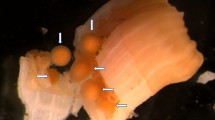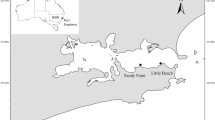Abstract
The global decline in reef health has prompted the need for effective management methodologies, including the development of active restoration measures. One such approach is the ‘gardening concept’ that involves use of underwater nurseries where coral fragments are farmed before their transplantation into denuded reefs. Here we document enhanced sexual reproduction in colonies of the coral Stylophora pistillata cultured in mid-water floating nursery situated in nutrient enriched water, near the fish farms in Eilat, Red Sea. We found that after 2 years of nursery, the average number of oocytes per polyp in farmed colonies was ca. 35% higher than in corresponding naturally growing colonies. Small branches in the nursery developed gravid colonies that released equal (or more) numbers of planula larvae as compared to similar size, 5-year old naturally growing colonies. These nursery-borne planulae possessed more zooxanthellae and contained more chlorophyll per larva. While settled and metamorphosed in equal rates compared to planulae originated from reef-grown colonies, the nursery borne planulae developed faster growing young colonies. We estimate that a coral nursery could generate, during the reproductive season, tens of millions of planula larvae and therefore should be regarded as a ‘larval dispersion hub’ that can be used as a management tool for natural recruitment enhancement.



Similar content being viewed by others
References
Bongiorni L, Shafir S, Angel D, Rinkevich B (2003) Survival, growth and gonadal development of two hermatypic corals subjected to in situ fish farm nutrient enrichment. Mar Ecol Prog Ser 253:137–144
Cowen RK, Paris CB, Srinivasan A (2006) Scaling of connectivity in marine populations. Science 311:522–527
Edwards AJ, Clark S (1998) Coral transplantation: a useful management tool or misguided meddling? Mar Pollut Bull 37:8–12
Epstein N, Bak RPM, Rinkevich B (1999) Implementation of a small-scale “no-use zone” policy in a reef ecosystem: Eilat’s reef-lagoon six years later. Coral Reefs 18:327–332
Epstein N, Bak RPM, Rinkevich B (2001) Strategies for gardening denuded coral reef areas: the applicability of using different types of coral material for reef restoration. Restor Ecol 9:432–442
Epstein N, Vermeji MJA, Bak RPM, Rinkevich B (2005) Alleviating impacts of anthropogenic activities by traditional conservation measures: can a small reef reserve be sustainedly managed? Biol Conserv 121:243–255
Frankham R (1999) Quantitative genetics in conservation biology. Genet Res Camb 74:237–244
Gerber LR, Botsford LW, Hastings A, Possingham HP, Gaines SD, Palumbi SR, Andelman S (2003) Population models for marine reserve design: a retrospective and prospective synthesis. Ecol Appl 13:S47–S64
Gleason DF, Brazeau DA, Munfus D (2001) Can self-fertilizing coral species be used to enhance restoration of Caribbean reefs? Bull Mar Sci 69:933–943
Heyward AJ, Smith LD, Rees M, Field SN (2002) Enhancement of coral recruitment by in situ mass culture of coral larvae. Mar Ecol Prog Ser 230:113–118
Hufford KM, Mazer SJ (2003) Plant ecotypes: genetic differentiation in the age of ecological restoration. Trends Ecol Evol 18:147–155
Jeffery SW, Humphrey JF (1975) New spectrophotometric equations for determining chlorophyll a, b, c1 and c2 in higher plants, algae and natural phytoplankton. Biochem Physiol Pflanz 167:191–194
Jones GP, Planes S, Thorrold SR (2005) Coral reef fish larvae settle close to home. Curr Biol 15:1314–1318
Jones TA (2003) The restoration gene pool concept: beyond the native versus non-native debate. Restor Ecol 11:281–290
Lockwood DR, Hastings A, Botsford LW (2002) The effects of dispersal patterns on marine reserves: does the tail way the dog? Theor Popul Biol 61(3):297–309
Loya Y (1976) The Red Sea coral Stylophora pistillata is an r-strategist. Nature 259:478–480
McKay JK, Christian CE, Harrison S, Rice KJ (2005) “How local is local?”—a review of practical conceptual issues in the genetics of restoration. Restor Ecol 13:432
Ogden JC (1997) Marine managers look upstream for connections. Science 278:1414–1415
Petersen D, Tollrian R (2001) Methods to enhance sexual recruitment for restoration of damaged reefs. Bull Mar Sci 69:989–1000
Raymundo LJH, Maypa AP, Luchavez MM (1999) Coral seeding as a technology for recovering degraded coral reefs in the Philippines. In: Proceedings of an international workshop on the rehabilitation of degraded coastal systems, no 20 (Spec Publ Phuket Mar Biol Cent), 19–24 January 1998, pp 81–90
Richmond R (1995) Coral reef health: concerns, approaches and needs. In: Proceedings of coral reef symposium on practices, reliable, low cost monitoring methods for assessing the biota and habitat conditions of coral reefs. US EPA & NOAA, Silver Spring, Maryland, pp 22–28
Rinkevich B (1995) Restoration strategies for coral reefs damages by recreational activities: the use of sexual and asexual recruits. Restor Ecol 3:241–251
Rinkevich B (2000) Steps towards the evaluation of coral reef restoration by using small branch fragments. Mar Biol 136:807–812
Rinkevich B (2005) Conservation of coral reefs through active restoration measures: recent approaches and last decade progress. Environ Sci Tech 39:4333–4342
Rinkevich B (2006) The coral gardening concept and the use of underwater nurseries: lessons learned from silvics and silviculture. In: Precht WE (ed) Coral reef restoration handbook—the rehabilitation of an ecosystem under siege. CRC Press, Boca Raton, pp 291–300
Rinkevich B, Avishai N, Rabinowitz C (2005) UV incites diverse levels of DNA breaks in different cellular compartments of branching coral species. J Exp Biol 208:843–848
Rinkevich B, Loya Y (1979a) The reproduction of the red sea coral Stylophora pistillata. I. gonads and planulae. Mar Ecol Prog Ser 1:133–144
Rinkevich B, Loya Y (1979b) The reproduction of the red sea coral Stylophora pistillata. II Synchronization in breeding and seasonality of planulae shedding. Mar Ecol Prog Ser 1:145–152
Rinkevich B, Loya Y (1983) Intraspecific competitive networks in the Red Sea coral Stylophora pistillata. Coral Reefs 1:161–172
Rinkevich B, Loya Y (1987) Variability in the patterns of sexual reproduction of the coral Stylophora pistillata at Eilat, Red Sea: a long-term study. Biol Bull 173:335–344
Risk MG (1999) Paradise lost: how marine science failed the world’s coral reefs. Mar Freshw Res 50:831–837
Roberts CM (1997) Connectivity and management of Caribbean coral reefs. Science 278:1454–1457
Sala E, Aburto-Oropeza O, Paredes G, Parra I, Barrera JC, Dayton PK (2002) A general model for designing networks of marine reserves. Science 298:1991–1993
Sammarco PW, Brazeau DA, Lee TN (1999) Enhancement of reef regeneration processes: supplementing coral recruitment processes through larval seeding. In: International conference science aspects coral reef assessment, monitoring, restoration. National Coral reef Institute, Nova Southeastern University, Florida, p 169
Shafir S, Van Rijn J, Rinkevich B (2006a) Steps in the construction of underwater coral nursery, an essential component in reef restoration acts. Mar Biol 149:679–687
Shafir S, Van Rijn J, Rinkevich B (2006b) Mid water coral nursery. In: Proceedings of 10th international Coral reef symposium, Okinawa, pp 1674–1679
Wilkinson CR (1999) Global and local threats to coral reef functioning and existence: review and predictions. Mar Freshw Res 50:867–878
Acknowledgments
This study was supported by INCO-DEV project (REEFRES, no.: 510657), by the World bank/GEF project (reef remediation/restoration working group) by the AID-CDR program (no.: C23-004) and by the EC CORALZOO project (no.012547-2). Field studies were performed in IUI, Eilat premises.
Author information
Authors and Affiliations
Corresponding author
Additional information
Communicated by S.A. Poulet, Roscoff.
Rights and permissions
About this article
Cite this article
Amar, K.O., Rinkevich, B. A floating mid-water coral nursery as larval dispersion hub: testing an idea. Mar Biol 151, 713–718 (2007). https://doi.org/10.1007/s00227-006-0512-0
Received:
Accepted:
Published:
Issue Date:
DOI: https://doi.org/10.1007/s00227-006-0512-0




